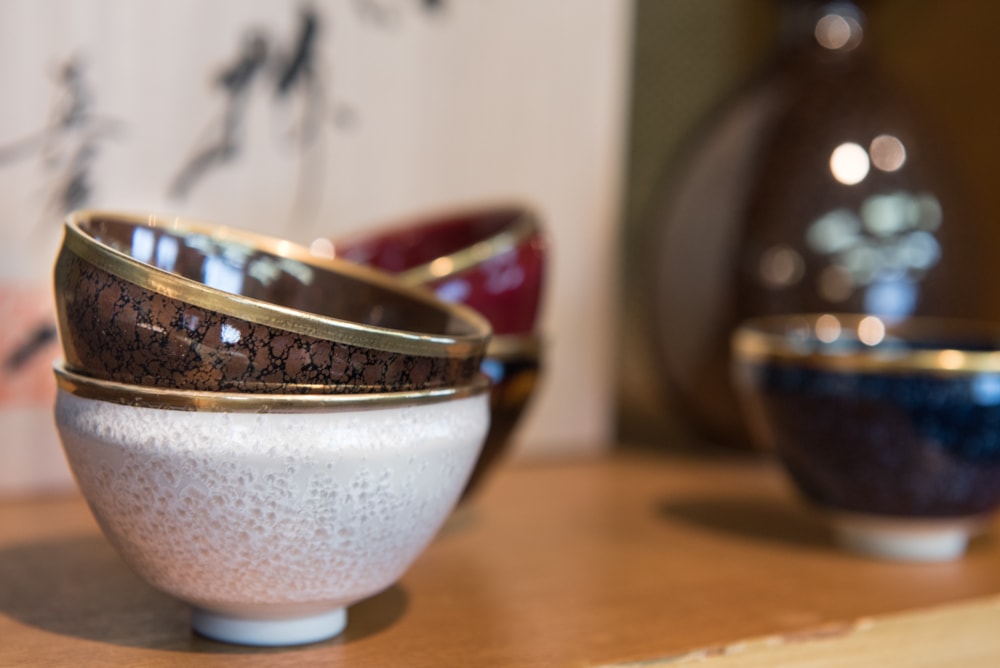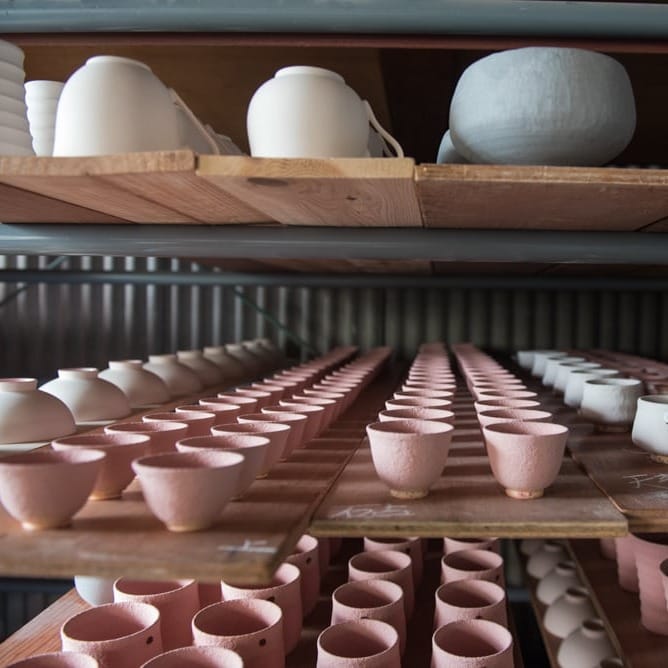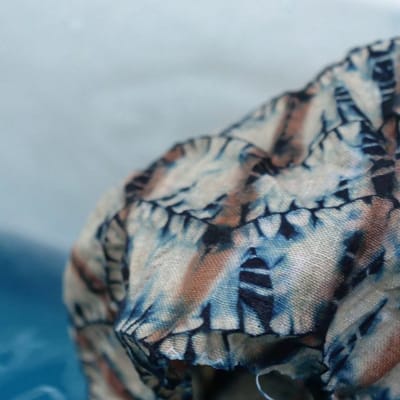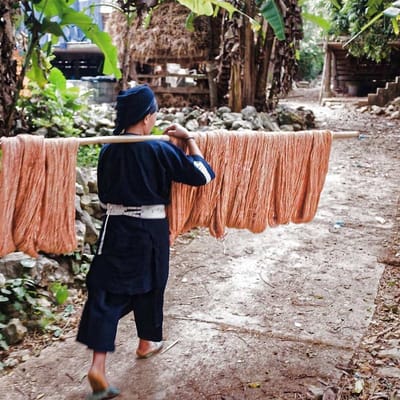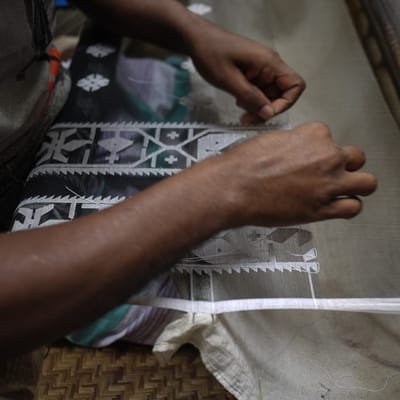It’s almost impossible to imagine a time when Japanese goods weren’t ubiquitous. But beginning in the 17th century, Japan heavily restricted all exports and, in essence, limited the sale of its products only to within the island nation. When its government liberalized trade policies again in 1868, the renewed flow of goods generated a frenzy for Japanese design in the West.
This period of Japonism, as it was called, affected art-makers and art-buyers alike: Japanese crafts like Ukiyo-e woodblock printing influenced French painters like Monet and the 1878 Paris Exposition Universelle created such a clamor for Japanese goods that one critic said it went beyond fashion and was, in fact, “evidence of fanaticism or insanity”. Porcelain from the town of Arita on Japan’s Kyushu island was especially coveted and, in the 10 year period following the Paris Expo, exports of Arita Ware (aritayaki) more than doubled.
This global demand fueled a thriving community of ceramicists and artists there, one which continues to this day. Contributor Laura Wheatley visited Shinemon Kiln, one of Arita’s most famous porcelain studios, to learn how the region’s intricate designs and glazes have evolved.
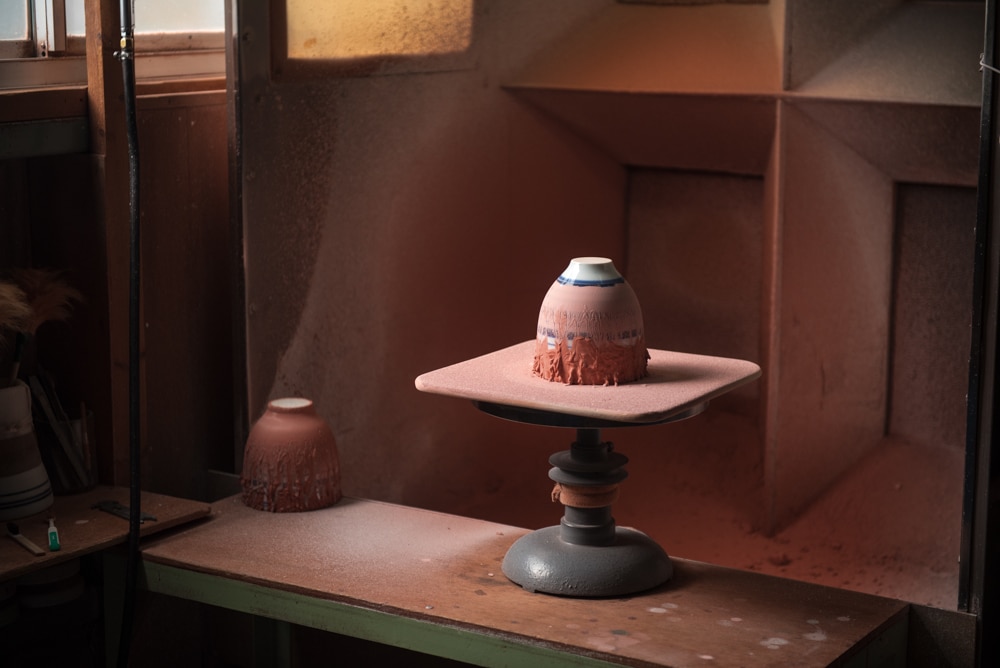
When I arrived in Arita, I discovered the town surrounded by two things: Lush green mountains and, as it turned out, also by the clouds of a typhoon expected to roll through the following day. I considered whether I should change my itinerary and just bunker down somewhere until it was all over, but throwing caution to the wind — literally, in this case — I decided instead to press on for a visit to Shinemon Kiln. It would become one of the most exhilarating experiences of my journey through Japan.
I was greeted at the Shinemon building by Mr. Kusuo Baba, his wife Mrs. Kumiko Baba, their son and third generation ceramic artisan Mr. Hisakazu Baba, and his wife, Mrs. Nagisa Baba. The family was friendly and hospitable, and I felt instantly at ease as they served me tea in the most stunning porcelain cup I had ever laid eyes on.
I learned that, in the early 17th century, potters found porcelain stone deposits in the area and the region developed into a magnet for ceramics production. The initial designs were intricate blue and white patterns but, over the years, artists also incorporated newer techniques, like red overglaze and the application of gold leaf in their Arita porcelain.
Shinemon Baba founded the Shinemon Kiln studio in 1972 and, like his father before him, became a talented ceramic artist. Unique for the time, he created larger ceramics such as vases. Starting with the signature blue and white designs of Arita, Shinemon Baba’s style eventually migrated towards yohen ware. Yohen means “changed by flame” – referring to the ceramics glazes which are transformed by firing in the kiln, often causing them to run. Furthering his exploration of yohen ware, he created various styles based on the chemical reactions of the various minerals encompassed in the glaze.
Shinemon Kiln continues to produce truly beautiful works of art under second generation Kusuo Baba (known professionally as Shinemon II) and his family of three sons, his wife, daughter-in-law, and several other artisans. Together, they produce an enchanting range of goods including a Cinnabar collection (below) named for the ruby red color that emerges in the kiln from copper in the glaze.
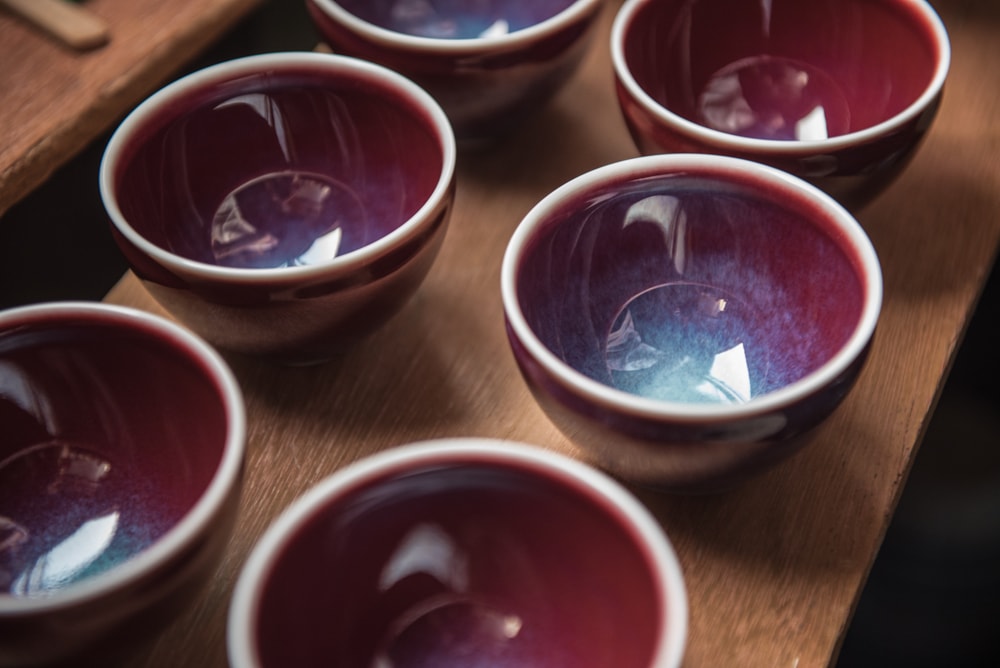
The artisans also use yusai techniques, which they described to me as “layers of different glazes, fusing together to create beautiful gradations of colors.” One such wonder of beautiful gradation is called Ginga, or “The Galaxy” (above, in gallery). After careful study, Shinemon II was able to use an unpredictable type of iron-containing glaze to recreate the appearance of millions of stars lighting up the galaxy.
After our tea, Kusuo Baba and Hisakazu Baba brought me to the studio, located behind the shop, to see these techniques up close. Rays of sunlight flowed freely through the windows, lighting up the spacious studio. Dozens of wooden planks lined with hundreds of ceramics were stacked, rack upon rack, throughout. Around us were Shinemon’s artisans, working on each step of the process.
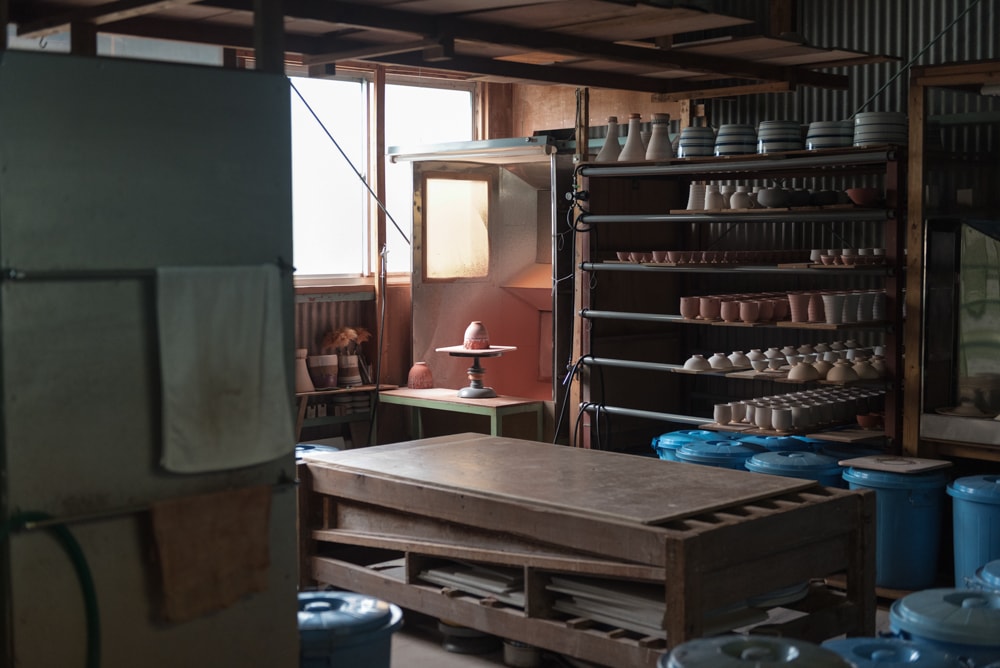
To my left I watched a man molding clay on the potter’s wheel, forming a wide-mouthed sake cup called a sakazuki. The clay must first be kneaded to force the air bubbles out, preventing air pockets from exploding in the kiln – a technique called “wedging.” After the clay body is created, it is left to dry until all the water has evaporated.
The unfired clay pottery then undergoes bisque firing in the kiln at around 900 degrees Celsius, hardening it and making it more durable for glazing. The Shinemon Kiln’s name is signed on the bottom of each piece with brush and ink.
Glaze can be applied in various ways, and saw several dipping, painting, and spraying methods during my visit. I watched as Mr. Kusuo Baba took a high-pressure spray gun and expertly applied glaze to the cups. He set each one back on the wooden plank to dry. Once the glaze has dried enough to handle, an artisan scrapes and sponges any excess from the bottoms – the porcelain must be free of any glaze before it enters the kiln.
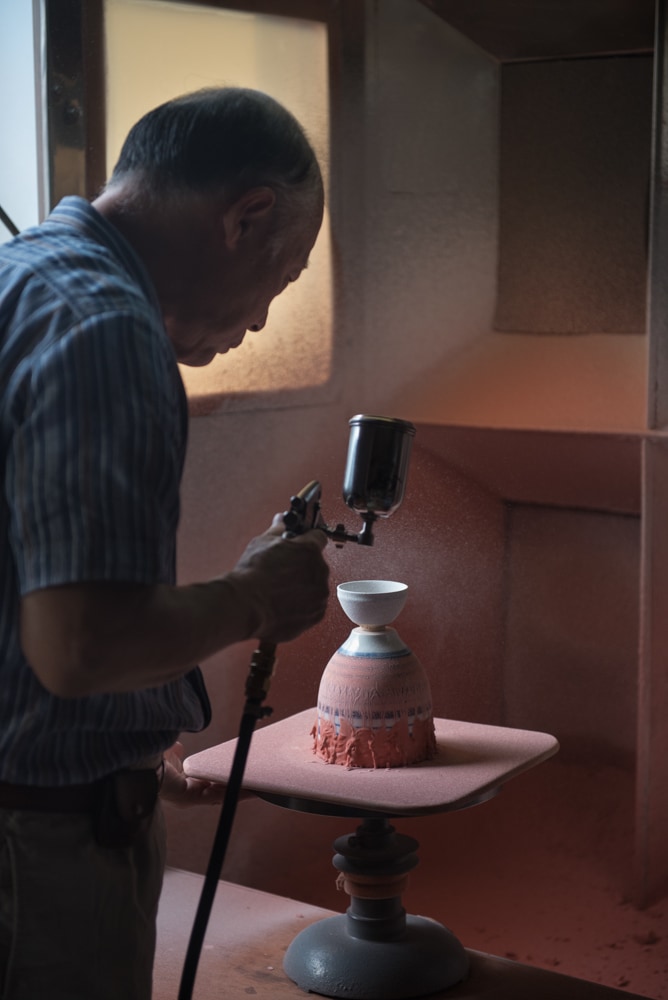
During firing, the pieces are heated in the gas kiln at around 1,300 degrees Celsius, though some types may undergo a slightly different process. I was fascinated while watching Hisakazu Baba as he slowly pulled a giant block of shelves containing their signature ruby-red Cinnabar pieces fresh from the kiln. Each row had the immaculate gleaming specimens lined up, ready to be inspected.
Once cooled, the pieces were unloaded onto wooden planks and, with what looked like a balancing act of great skill, were carefully carried over to the next station. Hisakazu Baba then took each piece and held it over a spinning grinding disk to smooth the bottoms, ensuring no rough parts would scratch surfaces when they're set down.
After the finishing process, the porcelain pieces were gently loaded into crates to be stored until they are displayed in the shop or sold online. We headed back to the main building to see Nagisa Baba who, using her impressive talents as a calligrapher, gracefully write on the wooden boxes which encase the final products.
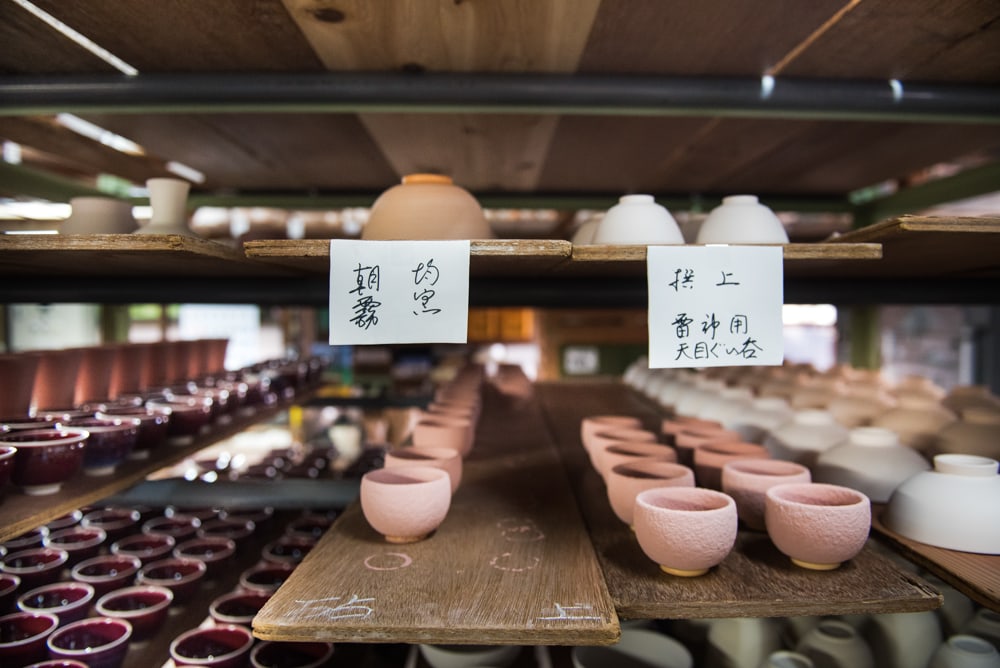
Kumiko Baba then guided me through some of their more unique designs, describing some of having various inspirations such as “fireworks” or “stars in the night sky”. An exquisite sake set done with a yuteki tenmoku glazing style stands out, appearing as though slivers of golden-brown crystals are floating on its surface. This glaze is usually done with earthenware due to its tendency to crack with more delicate materials. Kusuo Baba likes the challenge, though, and has mastered yuteki tenmoku using porcelain.
Just as I was expecting my visit to come to a close, I was surprised by a bountiful feast presented in their celebratory “special occasion” ceramics. Extremely honored — and suddenly quite hungry — I sat down and joined them for what would be one of the best meals I had while in Japan. I was delighted as Kumiko Baba instructed me how to enjoy each part of the meal properly. I joked that with the depth she went into, it felt like I was receiving "geisha lessons" – and I loved every minute of it.
Inevitably, though, it was time to go. I had to leave to catch the train and discover if my flight in Fukuoka would be cancelled due to the typhoon. Ever so sweetly, Kumiko Baba and Nagisa Baba offered to drive me to the station and see me off. I accepted their kindness and we waved exchanged smiles and farewells, waving goodbye to each other from opposite sides of the tracks.
